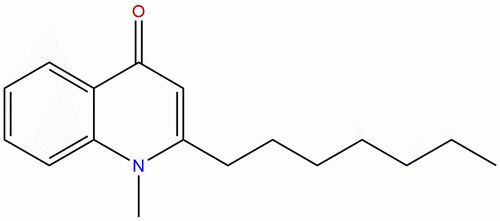
SchinifolineCAS No.:80554-58-1 |
||||||||||
 |
|
|
||||||||

| Catalogue No.: | BPF7283 |
| Formula: | C17H23NO |
| Mol Weight: | 257.377 |
| Botanical Source: | Zanthoxyli pericarpium |
Product name: Schinifoline
Synonym name: 1-Methyl-2-heptyl-4(1H)-quinolinone
Catalogue No.: BPF7283
Cas No.: 80554-58-1
Formula: C17H23NO
Mol Weight: 257.377
Botanical Source:
Physical Description:
Type of Compound: Alkaloids
Purity: 95%~99%
Analysis Method: HPLC-DAD or/and HPLC-ELSD
Identification Method: Mass, NMR
Packing: Brown vial or HDPE plastic bottle
The product could be supplied from milligrams to grams
Inquire for bulk scale.
For Reference Standard and R&D, Not for Human Use Directly.
Description:
Schinifoline has cytotoxic activity, it also shows in vitro radiosensitising, cell cycle and apoptotic-inducing effects.
References:
Molecules. 2014 Dec 1;19(12):20128-38.
Radiosensitizing effect of schinifoline from Zanthoxylum schinifolium Sieb et Zucc on human non-small cell lung cancer A549 cells: a preliminary in vitro investigation.
Schinifoline (SF), a 4-quinolinone derivative, was found in Zanthoxylum schinifolium for the first time. 4-Quinolinone moieties are thought to have cytotoxic activity and are often used as a tubulin polymerization inhibitors, heterogeneous enzyme inhibitors and antiplatelet agents. However, very little information respect to radiosensitization has focused on SF.
METHODS AND RESULTS:
This work aimed to investigate the radiosensitizing effect of SF on A549 cells. The cell viability results indicated cytotoxicity of SF on A549 cells, with IC50 values of 33.7 ± 2.4, 21.9 ± 1.9 and 16.8 ± 2.2 μg/mL, respectively, after 6, 12, 24 h treatment with different concentrations, and the 10% or 20% IC50 concentration during 12 h was applied in later experiments. The results of cell proliferative inhibition and clonogenic assay showed that SF enhanced the radiosensitivity of A549 cells when applied before 60Co γ-irradiation and this effect was mainly time and concentration dependent. The flow cytometric data indicated that SF treatment before the irradiation increased the G2/M phase, thus improving the radiosensitivity of A549, leading to cell apoptosis.
CONCLUSIONS:
This paper is the first study that describes the in vitro radiosensitising, cell cycle and apoptotic-inducing effects of Schinifoline.